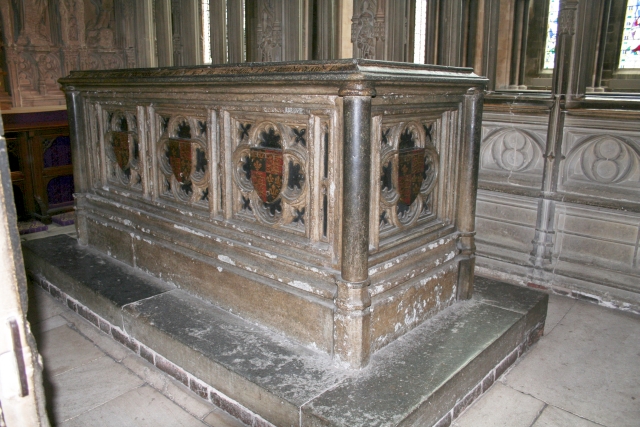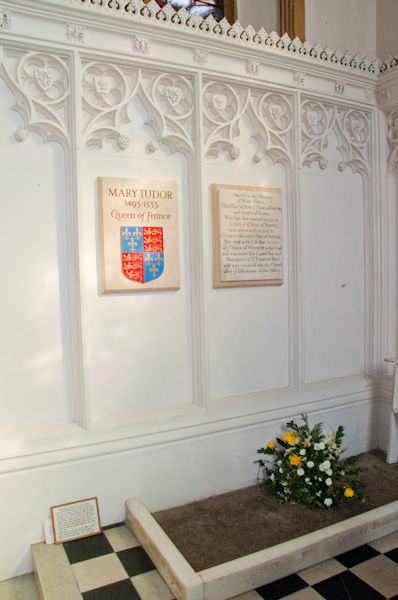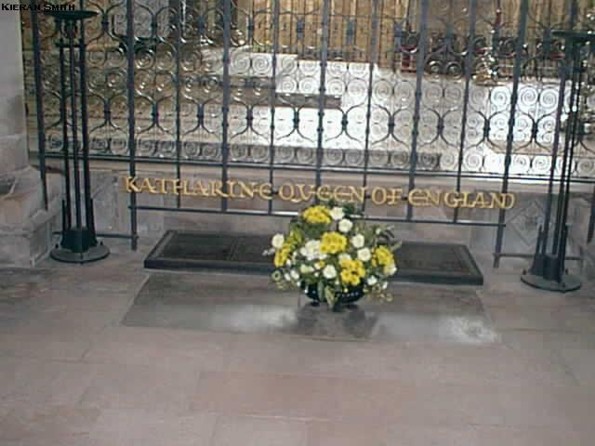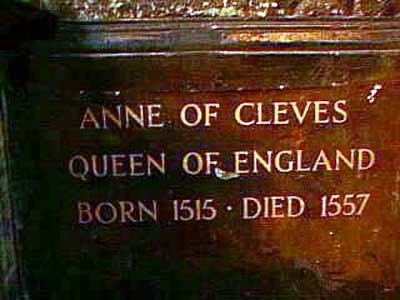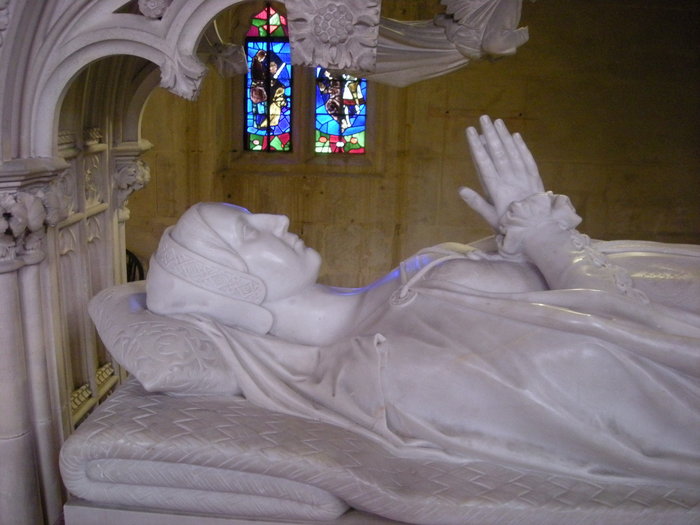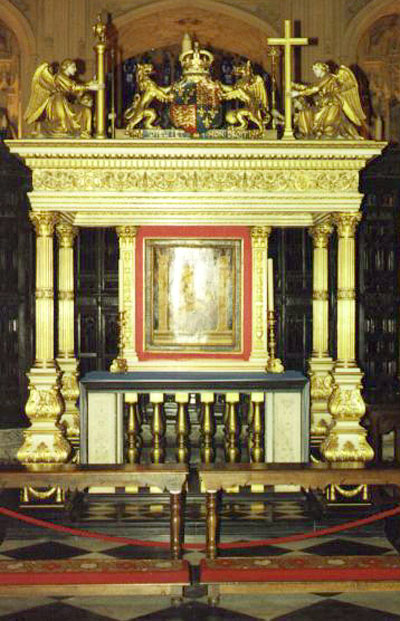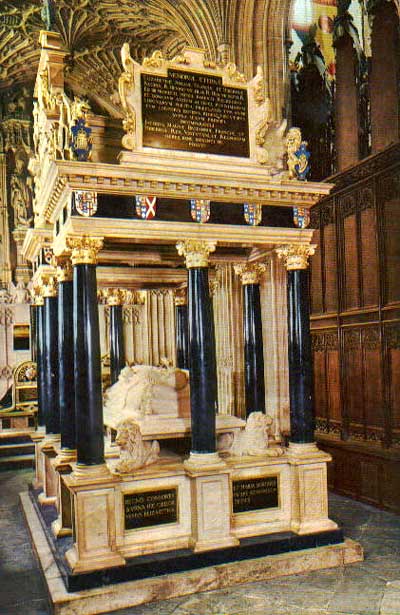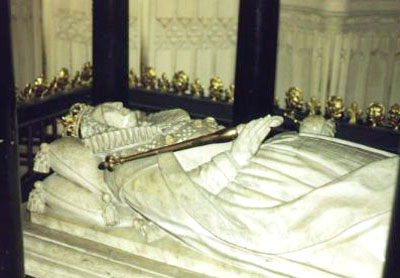by An Ard Rí and Susan Flantzer © Unofficial Royalty 2012
The Tudors ruled England from 1485 until 1603, held the Lordship of Ireland from 1485 until 1541, and held the Kingdom of Ireland from 1541 until 1603. The House of Tudor descended from Rhys ap Tewdwr, a king of Deheubarth in Wales. The first Tudor monarch, King Henry VII, was a descendant through his mother Margaret Beaufort of a legitimized branch of the House of Lancaster. The Tudor family rose to power during the Wars of the Roses, which left the House of Lancaster, to which the Tudors were aligned, extinct. In 1485, Henry Tudor defeated King Richard III of the House of York at the Battle of Bosworth Field and proclaimed himself King of England. Henry then married Elizabeth of York, eldest daughter of King King Edward IV of the House of York, thereby uniting the Houses of Lancaster and York into the new House of Tudor.
Tudor Monarchs
- Henry VII – reigned 1485-1509
- Henry VIII – reigned 1509-1547
- Edward VI – reigned 1547-1553
- Jane – reigned July 10, 1553-July 19, 1553
- Mary I – reigned 1553-1558
- Elizabeth I – reigned 1558-1603
Burial articles for all the British royal houses can be found at Unofficial Royalty: British Royal Burial Sites
An excellent resource: The Royal Tombs of Great Britain by Aidan Dodson, published in 2004
***********************
All portraits and photos are from Wikipedia unless otherwise noted.
Lady Margaret Beaufort, Countess of Richmond and Countess of Derby

Lady Margaret Beaufort was the mother of King Henry VII and a very influential figure during the Wars of the Roses. Margaret was the daughter and sole heiress of John Beaufort, 1st Duke of Somerset. Through her father, Lady Margaret Beaufort was a granddaughter of John Beaufort, 1st Earl of Somerset, a great-granddaughter of John of Gaunt, 1st Duke of Lancaster and his mistress and third wife Katherine Swynford, and a great-great-granddaughter of King Edward III of England. When she was 12-years-old, she married 24-year-old Edmund Tudor, 1st Earl of Richmond. A year later, Edmund died of the plague, leaving his 13-year-old widow seven months pregnant with their child, Henry Tudor, the future King Henry VII, her only child. Margaret married two more times.
Margaret lived two months into the reign of her grandson King Henry VIII, dying in the Deanery of Westminster Abbey on June 29, 1509, aged in her mid-60s. She was buried in the Henry VII Chapel at Westminster Abbey. Her tomb is now situated between the later graves of her descendants William III and Mary II and the tomb of her great-great-granddaughter Mary, Queen of Scots.

********************
Henry VII, King of England (reigned 22 August 1485 – 21 April 1509)

Henry VII, son of Edmund Tudor, 1st Earl of Richmond and Lady Margaret Beaufort, was the first Tudor monarch and took the throne following the defeat and death of Richard III at the Battle of Bosworth Field. Perhaps his most lasting legacy is the beautiful Henry VII Chapel in Westminster Abbey where he and his wife (and many others) are buried. Henry’s health began to fail in 1507, and he suffered from attacks of gout and asthma. King Henry VII died at Richmond Palace on April 21, 1509, at the age of 52. He lies buried with his wife Elizabeth in a tomb created by Italian artist Pietro Torrigiano in the Henry VII Chapel in Westminster Abbey.
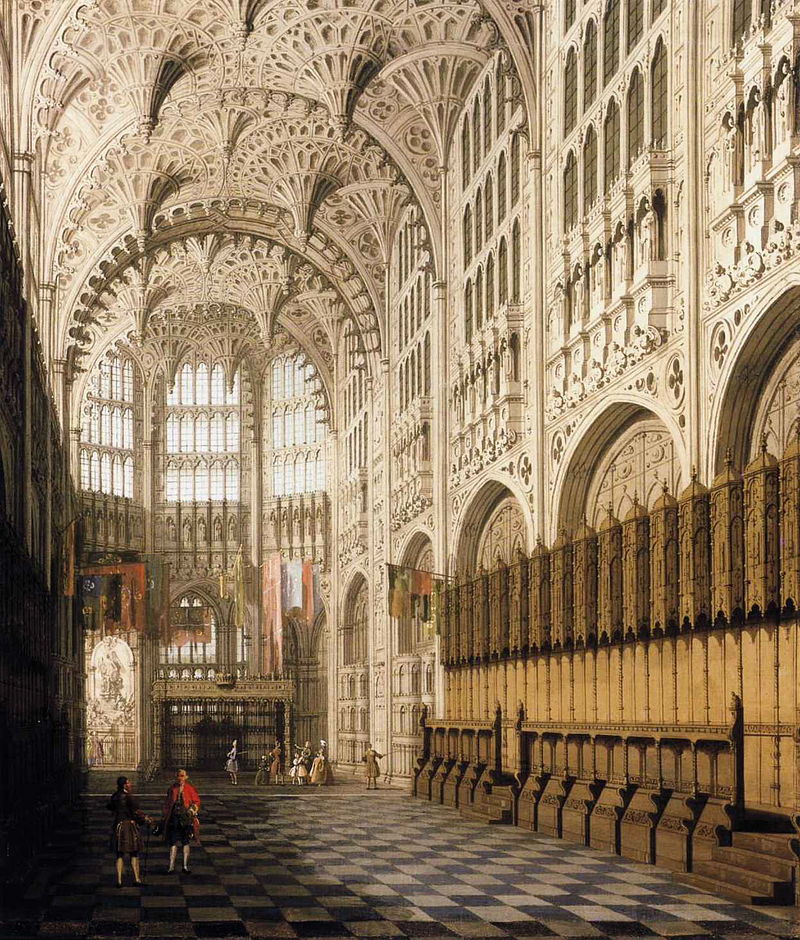
The Interior of Henry VII’s Chapel in Westminster Abbey by Canaletto
********************
Elizabeth of York, Queen of England

The eldest child of Edward IV and Elizabeth Woodville, she married Henry VII on 18 January 1486, thereby uniting the Houses of York and Lancaster into the new House of Tudor. On February 2, 1503, Elizabeth gave birth to her seventh child, a daughter, Katherine. Shortly after giving birth, Elizabeth became ill with puerperal fever (childbed fever) and died on February 11, 1503, her 37th birthday. Henry VII was so shaken by her death that he went into seclusion and would only see his mother. Little Katherine died on February 18, 1503. Elizabeth received a dignified state funeral in Westminster Abbey in the presence of her sisters. On her coffin was a wooden effigy, modeled on Elizabeth, wearing the insignia of the queen. The funeral procession was led by her sister Catherine of York. Elizabeth lies buried with her husband in a magnificent tomb in the Henry VII Chapel in Westminster Abbey.
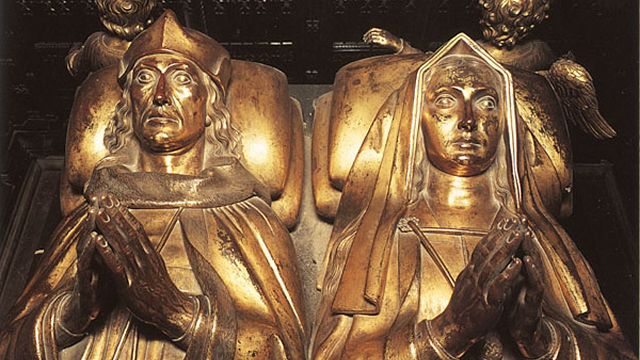
Tomb of Henry VII and Elizabeth of York in Westminster Abbey; Photo Credit – englishhistoryauthors.blogspot.com
********************
Arthur, Prince of Wales

The eldest son of Henry VII and Elizabeth of York, Arthur, Prince of Wales married Catherine of Aragon on November 14, 1501. After the marriage, the couple lived at Ludlow Castle in Shropshire, England near the Welsh border, where, as Prince of Wales, Arthur presided over the Council of Wales and the Marches. Within months of the marriage, both Arthur and Catherine became ill, probably of the sweating sickness. Catherine survived but she was left a widow as Arthur did not survive. Arthur, Prince of Wales died at Ludlow Castle on April 2, 1502, and was buried at Worcester Cathedral. His tomb suffered some damage during the Reformation but can still be seen today.
********************
Margaret Tudor, Queen of Scots

The eldest daughter of Henry VII and Elizabeth of York, Margaret Tudor was married to James IV, King of Scots in August 1503. Margaret was the mother of James V, King of Scots, her only surviving child, and the grandmother of both Mary, Queen of Scots and her second husband Henry Stuart, Lord Darnley. After the death of James IV, she married two more times: Archibald Douglas, 6th Earl of Angus in 1514 and Henry Stewart, 1st Lord Methven in 1528. After suffering a stroke, Margaret died at Methven Castle on October 18, 1541, at the age of 51. She was buried at the Carthusian Charterhouse in Perth, Scotland. Her tomb was destroyed and her remains were burned on May 11, 1559, when a mob of Calvinists attacked and destroyed the Charterhouse.
********************
Mary Tudor, Queen of France, Duchess of Suffolk

Mary was the youngest surviving daughter of Henry VII and Elizabeth of York. In October 1514 she was married to Louis XII of France. Following his death in 1515, she married Charles Brandon, 1st Duke of Suffolk. Their granddaughter was Lady Jane Grey. Mary’s health began to suffer around the time Henry VIII and Anne Boleyn married. There were rumors that the coronation of Anne Boleyn on June 1, 1533, broke Mary’s heart. Mary died at Westhorpe Hall on June 25, 1533, at the age of 37 and was originally buried in the Abbey at Bury St. Edmunds. In 1538, when the Abbey at Bury St. Edmunds was dissolved during the Dissolution of the Monasteries, Mary’s coffin was brought to St. Mary’s Church in Bury St. Edmunds where it still rests in the crypt. The original grave slab survives and is in the sanctuary near the altar. There is also a later inscription and insignia on the wall and a marble curb given by King Edward VII which can be seen in the photo below. In the Lady Chapel, there is a stained glass window given by Queen Victoria that depicts Mary’s life.
********************
Henry VIII, King of England (reigned 21 April 1509 – 28 January 1547)

Henry VIII succeeded his father King Henry VII in 1509 and married his late brother’s widow, Catherine of Aragon. He divorced Catherine in 1533 and married Anne Boleyn, whom he had beheaded three years later on charges of adultery. Henry then married Jane Seymour, who died in childbirth. He then went on to marry Anne of Cleves and shortly afterward had the marriage dissolved. Next, Henry married Katherine Howard and she too was beheaded on charges of adultery. Lastly, in 1543, Henry married Catherine Parr who outlived him.
Henry’s many health issues certainly hastened his death and after an eventful reign, he died at the age of 55 on January 28, 1547, at Whitehall Palace in London. There were plans for a tomb at St. George’s Chapel at Windsor Castle but at the time of his death, it was incomplete. In his will, Henry directed that he be buried with his third wife Jane Seymour, the wife that had given him a son, in the small vault in the quire of St. George’s Chapel and that their remains be moved to the tomb once it was completed. However, the tomb was never completed. In 1649, the remains of the beheaded King Charles I were buried in Henry and Jane’s vault.
- Unofficial Royalty: St. George’s Chapel in Windsor, England
- Unofficial Royalty: St. George’s Chapel, Windsor: Royal Burials

Coffins of King Henry VIII (center, damaged), Queen Jane (right), King Charles I with a child of Queen Anne (left), vault under the choir, St George’s Chapel, Windsor Castle, marked by a stone slab in the floor; Credit – Wikipedia
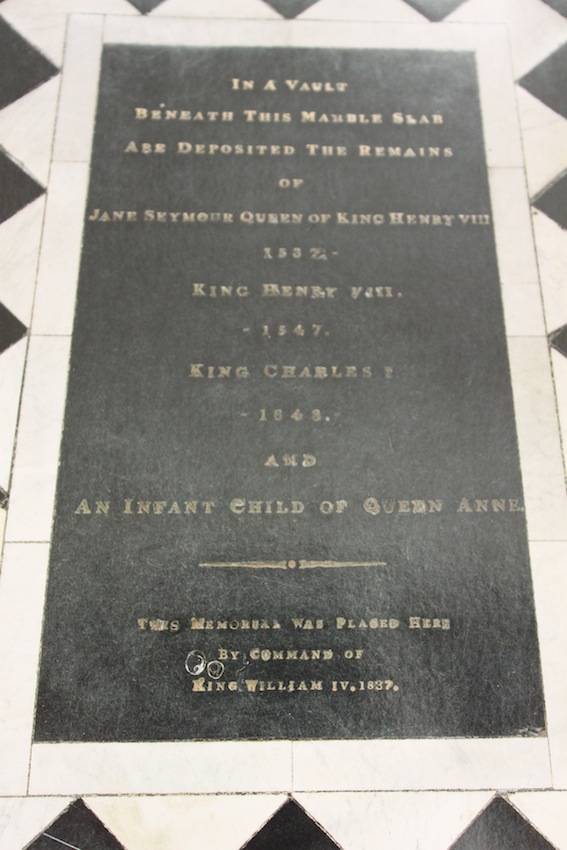
Stone slab in the floor indicating tomb of Henry VIII and his third wife Jane Seymour; Photo Credit – onthetudortrail.com
Catherine of Aragon, Queen of England

The daughter of Isabella I of Castile and Ferdinand II of Aragon, the Catholic Monarchs, Catherine first was married to Arthur, Prince of Wales, and then to his younger brother, Henry VIII. Catherine was the mother of Mary I. Her inability to bear a male heir caused Henry to seek a divorce from her in 1533. Following her divorce, broken and humiliated, Catherine died at Kimbolton Castle on January 7, 1536. Rumors were circulated that she had been poisoned. Her embalmer described her heart as “quite black and hideous to look at” with a “black round body stuck to the outside.” Modern doctors suspect that her heart’s discoloration was due to cancer.
Catherine was buried at Peterborough Cathedral on January 29, 1536, but her daughter Mary was not allowed to attend her funeral. A cortege from Kimbolton Castle brought Catherine’s remains to Peterborough Abbey, now Peterborough Cathedral. It was the nearest great religious place and Henry did not want to move her remains to London as it would have given the wrong message. The cortege was covered in black velvet, pulled by six horses, and accompanied by 50 servants in suits made of black fabric, carrying banners and torches. The cortege was met by four bishops and six abbots, and 1,000 candles lit up the abbey, where three masses were held as part of the funeral.
Catherine was buried in an elaborate black marble tomb gilded with gold. The gold was stolen by Oliver Cromwell’s soldiers during the English Civil War. The marble tomb survived into the 18th century when it was taken apart by one of the deans of the cathedral for the floor of his summer house. In 1895, Katharine Clayton, the wife of one of the canons at the cathedral, decided something should be done to restore Catherine’s tomb, so she launched an appeal for Katharines/Katherines/Catherines around England to donate money towards the project. Every year around the anniversary of her death, a service commemorating Catherine of Aragon’s life is held at Peterborough Cathedral. Catherine’s grave is visited by many people each year, some of whom leave flowers and pomegranates, Catherine’s heraldic symbol.
Anne Boleyn, Queen of England

Married in 1533, Anne Boleyn was the second wife of Henry VIII and the mother of Elizabeth I. Upset that Anne did not produce a son and already attracted to Jane Seymour, one of Anne’s maids of honor, Henry was determined to be rid of her, and her fall and execution were engineered by Thomas Cromwell, Henry’s chief minister. Many historians believe that the case charging Anne with adultery with her brother George Boleyn and four other men (Francis Weston, Henry Norris, William Brereton, and Mark Smeaton) was completely fabricated. She was brought to trial, found guilty, and then beheaded on May 19, 1536. Anne’s body was placed in an oak chest and she was buried in an unmarked grave in the Chapel of St. Peter-ad-Vincula at the Tower of London. In 1876, Anne’s remains were identified during renovation work and her grave is now marked by a plaque on the chapel floor.
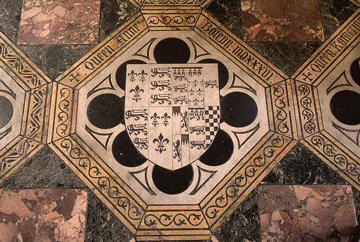
Anne Boleyn’s remains are directly beneath this seal on the altar floor of the Chapel of St. Peter ad Vincula; Photo Credit – findagrave.com
Jane Seymour, Queen of England

On May 30, 1536, King Henry VIII was married to Jane Seymour in a private ceremony held in the Queen’s Closet at Whitehall Palace. Henry and Jane had been betrothed on May 20, 1536, a day after the execution of Henry’s second wife Anne Boleyn.
Early in 1537, Jane became pregnant. The joyous king fulfilled Jane’s every desire and made sure she was attended by the best doctors and midwives. At 2 AM, on October 12, 1537, the long-awaited male heir was born at Hampton Court Palace. Jane’s labor had been long, two days and three nights. Three days later, the baby was christened Edward after Edward the Confessor whose feast day is October 13. His half-sisters Mary (daughter of Catherine of Aragon) and Elizabeth (daughter of Anne Boleyn) attended the ceremony along with his mother who was carried on a litter.
On October 17, 1537, Jane’s condition deteriorated and she was given the last rites. She died at Hampton Court Palace on October 24, 1537, most likely from puerperal fever or childbed fever, a bacterial infection. The majority of child-bed fever cases were caused by the birth attendants themselves. With no knowledge of germs, it was believed that hand washing was unnecessary.
Jane was buried on November 12, 1537, in St. George’s Chapel at Windsor Castle. Mary, Henry’s elder daughter, was the chief mourner. Henry’s plans to build a magnificent monument over Jane’s tomb never happened. In 1547 and three wives later, Henry VIII died and was laid to rest with Jane. In 1649, after his execution by beheading, King Charles I was laid to rest in the same vault as Henry and Jane. The only memorial to the three is a plaque on the floor put there by King William IV in 1837.
- Unofficial Royalty: St. George’s Chapel in Windsor, England
- Unofficial Royalty: St. George’s Chapel, Windsor: Royal Burials
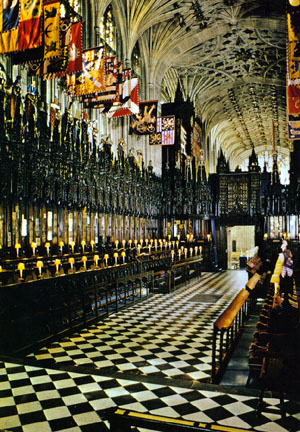
Jane Seymour is buried with Henry VIII under the slab in the choir of St. George’s Chapel; Photo Credit – findagrave.com
Anne of Cleves, Queen of England

Anne of Cleves was the daughter of John III, Duke of Jülich, Cleves and Berg and Maria, Duchess of Julich-Berg. In January 1540, she was married to Henry VIII at the Palace of Placentia. Henry was terribly disappointed by his new bride. He found Anne humorless and boring. She looked unimpressive in her German costume, acted shy and did not speak English. It was hoped that the wedding night would bring the couple closer together but the marriage was never consummated and it was said that the couple spent the night playing cards.
Henry had the marriage annulled on July 9, 1540. Anne was given a generous settlement and the use of Richmond Palace and Hever Castle. She was frequently at court, had a cordial relationship with Henry and his children. Anne of Cleves survived Henry and all his wives. Her last public appearance was at the coronation of her stepdaughter Queen Mary I.
In the spring of 1557, Anne became ill and died at the age of 41 on July 16, 1557, at Chelsea Manor, probably from cancer. Anne was buried with pomp and ceremony at Westminster Abbey on the south side of the altar. Her plain marble tomb has since been used for regalia and plate display at coronations and royal weddings.

Tomb of Anne of Cleves; Photo Credit – Westminster Abbey
Catherine Howard, Queen of England
The fifth wife of Henry VIII, Catherine Howard, was a member of the powerful Howard family and was a first cousin of Anne Boleyn. She married Henry VIII on July 28, 1540, just a few weeks after his marriage to Anne of Cleves had been annulled. Henry called his teenage bride his “rose without a thorn.”
Catherine’s previous affair with Francis Dereham, first her Private Secretary and then a Gentleman Usher of the Queen’s Chamber, and her current affair with Thomas Culpeper, a Gentleman to the King’s Privy Chamber, caused her downfall. Francis Dereham and Thomas Culpeper were executed on December 1, 1541, and both their heads were placed on spikes on top of London Bridge.
Catherine had been aided and abetted by her lady-in-waiting, Jane Boleyn, Viscountess Rochford, the widow of George Boleyn, who had been accused, convicted and executed for adultery with his sister Anne Boleyn. Catherine was brought to the Tower of London on February 10, 1542, by barge, passing under London Bridge where Dereham and Culpepper’s heads were displayed and remained displayed until 1546. Her execution by beheading was to take place on February 13, 1542, at 7:00 AM. The night before her execution, Catherine is believed to have practiced how to lay her head upon the block, which had been brought to her at her request. Catherine was beheaded with one stroke on Tower Green within the Tower of London. Jane Boleyn, Viscountess Rochford, was executed immediately afterward. Catherine Howard was buried in an unmarked grave in the nearby Chapel of St. Peter ad Vincula.

Catherine Howard’s memorial on the altar floor of the Chapel of St. Peter ad Vincula; Photo Credit – findagrave.com
Catherine Parr, Queen of England

Catherine Parr, the last wife of Henry VIII, married him on July 12, 1543, at Hampton Court Palace. Henry’s health was not good and he now required a nurse rather than a wife. Catherine proved to be a good nurse to Henry and a kind stepmother to his three children. She was influential in Henry’s passing of the Third Succession Act in 1543 which restored both his daughters, Mary and Elizabeth, to the line of succession to the throne.
After Henry’s death in 1547, Catherine married Thomas Seymour, uncle of King Edward VI. In August 1548, Catherine and Seymour had a daughter but tragically 36-year-old Catherine died on September 5, 1548, of puerperal fever or childbed fever at Sudeley Castle in Gloucestershire. Six months after Catherine’s death, Thomas Seymour was beheaded for treason and their daughter Mary Seymour appears to have died young.
Lady Jane Grey, who lived with Catherine until her death, was the chief mourner at her funeral. Catherine was buried in St. Mary’s Chapel at Sudeley Castle. Her grave was discovered in 1728 after the castle and the chapel had been left in ruins by the English Civil War. She was later re-interred by the Rector of Sudeley in 1817 and an elaborate tomb was built in her honor.
********************
Edward VI King of England (reigned 28 January 1547 – 6 July 1553)

The son of Henry VIII and Jane Seymour, Edward VI succeeded his father as King in 1547 when he was nine-years-old. Edward was given a strong education and his tutors also imparted to him the tenets of the Protestant Reformation that had swept through Germany and the Netherlands.
In January 1553, Edward became ill with a fever and cough that gradually worsened. It is probable that he had tuberculosis. By May 1553, the royal doctors had no hope that the king would recover. After great suffering, fifteen-year-old King Edward VI died on July 6, 1553, at Greenwich Palace. King Edward VI had a Protestant funeral conducted by Thomas Cranmer, Archbishop of Canterbury and was buried in the Henry VII Chapel at Westminster Abbey on August 8, 1553.
********************
Lady Frances Brandon, Duchess of Suffolk

Lady Frances Brandon was the elder of the two daughters of Mary Tudor, Queen of France and Charles Brandon, 1st Duke of Suffolk who survived childhood. In 1533, Frances Brandon was married to Henry Grey, Marquess of Dorset. Lady Jane Grey was the eldest of their three children, all daughters.
As the young King Edward VI lay dying, plotting occurred to pass over Edward’s Catholic half-sister Mary. Edward composed a document “My devise for the succession” in which he passed over his half-sisters Mary and Elizabeth and cousin Frances. Edward meant for the throne to go to the Frances’ daughters and their male heirs. Frances and her husband were outraged at her removal from the succession, but after a meeting with the ailing king, Frances renounced her rights in favor of her daughter Jane. Apparently, Jane did not have any idea of what was occurring.
Lady Jane Grey’s story is a familiar one. She was queen for nine days until Mary came to London with troops and was proclaimed queen. Lady Jane and her father, among others, both lost their heads.
Frances married her Master of the Horse Adrian Stokes in March 1555. They had two stillborn children and a daughter who died in infancy. Frances, aged 42, died on November 20, 1559, at her residence Charterhouse in London with her daughters Catherine and Mary at her side. The cost of her funeral was paid by her cousin Queen Elizabeth I. With her daughter Catherine acting as chief mourner, Frances was buried at Westminster Abbey. Four years later, her widower Adrian Stokes had a beautiful tomb and effigy placed over her grave with this epitaph in Latin:
Nor grace, nor splendor, nor a royal name,
Nor widespread fame can aught avail;
All, all have vanished here.
True worth alone survives the funeral pyre and silent tomb.
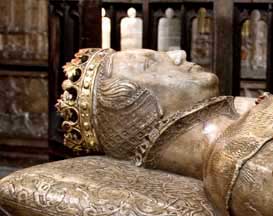
Lady Frances Brandon; Photo Credit – http://www.westminster-abbey.org/our-history/people/frances-brandon
********************
Lady Jane Grey, Queen of England

- Unofficial Royalty: Lady Jane Grey, Queen of England
- Unofficial Royalty: Execution of Lady Jane Grey, Queen of England
Jane was the eldest daughter of Henry Grey, Duke of Suffolk and Lady Frances Brandon, the daughter of Henry VIII’s sister Mary Tudor. Following the death of Edward VI, she was proclaimed Queen of England and Ireland. She was never crowned and her reign lasted but nine days. Lady Jane Grey was convicted of high treason and was beheaded on February 12, 1554, at Tower Green in the Tower of London. Her body was taken to the Chapel of St Peter ad Vincula at the Tower of London for burial.
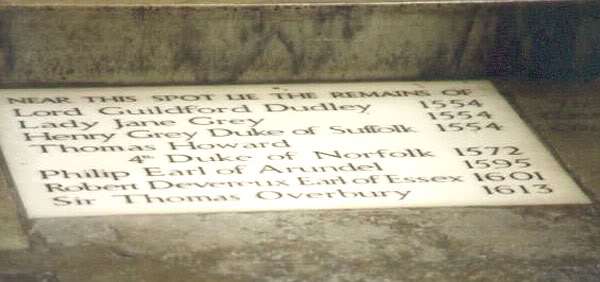
Memorial in the Chapel of St Peter ad Vincula at the Tower of London, Photo source: www.findagrave.com
********************
Mary I, Queen of England (reigned 19 July 1553 – 17 November 1558)

Queen Mary I was the only surviving child of Henry VIII and his first wife Catherine of Aragon. Mary succeeded her half-brother Edward VI in 1553 after the nine-day reign of Lady Jane Grey. As the 15-year-old King Edward VI lay dying, probably of tuberculosis, in the late spring and early summer of 1553, many feared that the succession of his Catholic half-sister Mary would spell trouble for the English Reformation. The Protestant Lady Jane Grey, the granddaughter of Henry VIII’s sister Mary Tudor, was proclaimed queen in an attempt to prevent the Catholic Mary from coming to the throne. However, the Privy Council switched their allegiance from Jane to Edward’s sister Mary and proclaimed her Queen on July 19, 1553. Mary arrived triumphantly into London on August 3, 1553, accompanied by her half-sister Elizabeth and a procession of over 800 nobles and gentlemen. Ultimately, Lady Jane, her husband, her father and her father-in-law would all lose their heads.
Mary knew it was vital that she marry and produce a Catholic heir to supplant her Protestant sister Elizabeth. A marriage to the future King Philip II of Spain was unsuccessful and did not provide an heir.
Mary had become weak and ill in May 1558, possibly from ovarian cysts or uterine cancer. Then In November 1558, Mary fell ill during an influenza outbreak and she died on November 17, 1558, at the age of 42. Mary had wanted to be buried with her mother at Peterborough Cathedral but was buried in Westminster Abbey in a vault she would eventually share with her Protestant sister and successor Queen Elizabeth I. The tomb erected above only has Elizabeth’s effigy but King James I, Elizabeth’s successor, ordered this to be inscribed upon the tomb in Latin:
Regno consortes et urna, Hic obdorminus Elizabetha et Maria sonores in spe resurrectionis
Partners both in throne and grave, here we, Elizabeth and Mary, rest as sisters, in hope of our resurrection.
********************
Elizabeth I, Queen of England (reigned 17 November 1558 – 24 March 1603)

Queen Elizabeth I, the daughter of Henry VIII and Anne Boleyn, succeeded her half-sister Mary in November 1558. Known as the Virgin Queen because she never married, Elizabeth had a reign of 44 years and was the last Tudor monarch. During her long reign, called the Elizabethan Age, the Church of England took its final form, a middle path between Catholicism and Reform Protestantism, William Shakespeare created numerous works, modern science had its birth based upon Francis Bacon‘s inductive method for scientific inquiry, Francis Drake sailed around the world, and the first colony in America was founded and named Virginia in honor of Elizabeth the Virgin Queen.
In January 1603, while suffering from a cold, Elizabeth moved from Whitehall Palace to Richmond Palace. She recovered from the cold but fell ill at the end of February with severe tonsillitis. She had no appetite and suffered from insomnia. On March 18, 1603, she became very ill and refused to go to bed, instead lying on a heap of pillows piled on the floor. When Robert Cecil, 1st Earl of Salisbury, her chief minister, urged her to go to bed, Elizabeth showed a last flash of her feisty spirit and said to him, “Little man, little man, MUST is not a word to use to princes.”
Since none of the children of Henry VIII had children, King James VI of Scotland, the only child of Mary, Queen of Scots, was the senior heir of King Henry VII through his eldest daughter Margaret Tudor. On her deathbed, Queen Elizabeth finally gave her assent that James should succeed her. Queen Elizabeth I died on March 24, 1603, at the age of 69 and was buried in the same vault as her sister Queen Mary I in Westminster Abbey. The tomb erected above only has Elizabeth’s effigy, but King James I ordered this to be inscribed upon the tomb in Latin:
Regno consortes et urna, Hic obdorminus Elizabetha et Maria sonores in spe resurrectionis
Partners both in throne and grave, here we, Elizabeth and Mary, rest as sisters, in hope of our resurrection.
********************
This article is the intellectual property of Unofficial Royalty and is NOT TO BE COPIED, EDITED, OR POSTED IN ANY FORM ON ANOTHER WEBSITE under any circumstances. It is permissible to use a link that directs to Unofficial Royalty.

